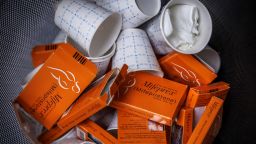Editor’s Note: Michele Goodwin is the Chancellor’s Professor of Law at the University of California, Irvine. She is the author of “Policing The Womb: Invisible Women and the Criminalization of Motherhood.” Mary Ziegler is the Martin Luther King Professor of Law at the University of California, Davis. She is the author of “Roe: The History of a National Obsession” and “Dollars for Life: The Anti-Abortion Movement and the Fall of the Republican Establishment.” The views expressed in this commentary the authors’ own. View more opinion on CNN.
Dueling decisions in two federal district courts last week are likely to set up a showdown at the Supreme Court over the fate of the abortion pill mifepristone. If abortion opponents are successful, access to the pill — reportedly used in more than half of abortions in the United States — will be severely undercut.


Beyond the dangerous precedent this sets for challenges to other important FDA-approved drugs that some political factions don’t like, the case is an alarming expression of the way right-wing activists are using junk science to bypass the will of the American public and restrict abortion.
US District Judge Matthew Kacsmaryk of Texas blocked the use of mifepristone Friday after the Alliance for Hippocratic Medicine, a group of anti-abortion doctors, employed dubious arguments to challenge the medication’s approval by the Food and Drug Administration in 2000.
The group alleges that the FDA failed to engage in a rigorous review of the drug, lacked the authority to approve the drug and rushed it to market without thorough consideration of the health implications (the Alliance Defending Freedom, which represents the plaintiffs, claims that the drug imperils the health and even lives of pregnant women.)
The FDA, in appealing the Texas ruling, supported its process for authorizing Mifiprex, the brand name for mifepristone. The “FDA approved Mifeprex more than 20 years ago based on a comprehensive review of the scientific evidence available and determined that it was safe and effective,” the agency said. “The approval was based on the best available science and done in accordance with the laws that govern our work.”
The Texas suit additionally claims that mifepristone was criminalized under the 1873 Comstock Act, a federal law that prohibits mailing any “article or thing designed, adapted, or intended for producing abortion.” That legal interpretation would limit access to mifepristone because drug suppliers need to ship it to providers.
For now, the drug remains available. Kacsmaryk gave the government a week to file an appeal, which is among the legal measures underway to keep the ruling from going into effect. At the same time, in a case brought by 17 states and the District of Columbia, U.S. District Judge Thomas Owen Rice in Washington state ordered the FDA to keep mifepristone available in those jurisdictions.
The states had argued that the FDA should lift some of the restrictions on mifepristone access, which they argued were unnecessary and unsupported by science. Rice instead ordered the FDA to preserve access in the states that had brought suit.
Kacsmaryk’s ruling is unprecedented. It is rare for parties to challenge the FDA’s approval of drugs, but for a judge to second-guess a decision on a drug that has safely been on the market for more than 20 years is just about unheard of — especially when there is no legitimate case that the plaintiffs have the standing to sue.
Any fair investigation of the FDA’s process would show that there are no grounds for challenging mifepristone’s approval, especially 23 years after the fact. The drug received extensive review — more than four years — before FDA approval. Moreover, claims that mifepristone threatens the health of those who take it are unfounded. The drug has a better safety record for use than Viagra and penicillin. Notably, it was available and used for years without incident in Europe.
Altogether, for those who take mifepristone “serious side effects occur in less than 1% of patients, and major adverse events—significant infection, blood loss, or hospitalization—occur in less than 0.3% of patients. The risk of death is almost non-existent.”
The case was never about the safety of mifepristone, however. Anti-abortion groups like the ADF cling to dubious scientific claims to bypass majority politics, putting decisions in the hands of conservative judges and confusing voters who don’t always feel qualified to have an opinion on how a drug like mifepristone works.
Since 2022, voters have sent a clear message when the question is what abortion law ought to look like: They have sided with supporters of abortion rights in six out of six ballot initiatives, boosted Democratic candidates and, just last week, transformed the Wisconsin Supreme Court. A recent Ipsos poll found that nearly two-thirds of Americans want medication abortion to be kept legal.
Kacsmaryk’s ruling is part of a strategy to take the question away from voters and to reframe abortion as something that ordinary Americans neither understand nor get a say about. Such an approach isn’t new, and it’s not going anywhere anytime soon; if the anti-abortion movement can’t win in a fair democratic fight, its members will seek out ways to change the rules.
Many antiabortion groups have long tried to undermine abortion by claiming that it harms girls and women — and that abortion opponents were seeking to protect pregnant people from the “abortion industry.”
This strategy underwrote targeted regulations of abortion providers (TRAP laws), onerous clinic regulations and statutes forcing women to receive medically unnecessary and invasive vaginal ultrasounds. State legislatures enacted burdensome laws requiring waiting periods before a woman can legally terminate a pregnancy. This all despite the fact that a woman is about 14 times more likely to die by carrying a pregnancy to term than having an abortion.
When the Supreme Court upheld the federal Partial-Birth Abortion Ban Act in 2007, dubious scientific arguments became even more central to anti-abortion advocacy. In Gonzales v. Carhart, the court held that in circumstances of scientific uncertainty, legislators would have more latitude to regulate abortion. That incentivized antiabortion groups to identify or manufacture uncertainty by creating their own data and fielding their own witnesses.
Implausible scientific claims are now visible on social media, in lawsuits and in congressional hearings. In a separate fight, for example, the antiabortion group Students for Life of America has asked the FDA to reconsider its mifepristone approval by making claims about the ill effects of abortion on wastewater.
Get our free weekly newsletter
- Sign up for CNN Opinion’s newsletter.
- Join us on Twitter and Facebook
In Congress, abortion opponents testified — contrary to the position taken by the American College of Obstetricians and Gynecologists — that life-saving abortions, or even abortions in cases of rape, were not “abortions” at all. (By taking this position, abortion opponents can still defend bans with no or few exceptions by claiming that abortion is never necessary.)
That Kacsmaryk embraced snake-oil science underscores concerns that broader dangers loom. If his ruling stands, this case sends a message that challengers don’t need to have science on their side, or even the standing, to sue. All that matters is control of the courts.








